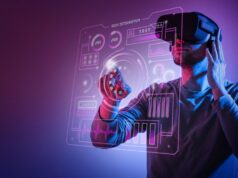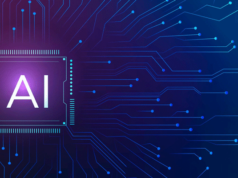The Role of AI in Cybersecurity: Protecting Digital Landscapes
In a period dominated by computerized innovation and mechanical progression, the significance of securing our advanced scenes has never been more basic. The remarkable development of cyber threats, ranging from complex malware to cutting-edge persevering threats, requires a change in perspective in cybersecurity procedures. Enter (AI), a unique advantage in the domain of cybersecurity. This article dives into the complex job of AI in fortifying our computerized environments and investigates how AI-driven cybersecurity solutions are shaping the eventual fate of advanced security
Artificial Intelligence in Cybersecurity
The combination of artificial intelligence and cybersecurity is reshaping the manner in which associations safeguard against evolving cyber threats. Customary cybersecurity draws near, relying intensely on rule-based frameworks, battle to stay up with the unique idea of contemporary threats. AI, nonetheless, introduces a degree of flexibility and intelligence that is transforming the cybersecurity scene.
AI in cybersecurity involves the utilization of cutting edge calculations and computational models to break down huge measures of information, recognize examples, and pursue constant choices to foil expected threats. This approach improves the productivity and viability of cybersecurity measures, offering a proactive protection against malevolent exercises.
AI-driven Cybersecurity Solutions
AI-driven cybersecurity solutions influence machine learning, deep learning, and other AI methods to upgrade danger location, incident reaction, and general security acts. These solutions go past conventional mark-based strategies and adjust to the evolving danger scene.
Machine learning calculations draw in designs to gain from obvious information, identifying inconsistencies and potential threats with more critical accuracy. Deep learning, a subset of machine learning, engages AI frameworks to copy human-like intellectual abilities, providing a more nuanced understanding of obfuscated threats.
Protecting Digital Landscapes with AI
The computerized scene is a huge and interconnected environment, making it powerless against a bunch of cyber threats. AI assumes a critical part in protecting this extensive terrain by continuously monitoring and analyzing network exercises. Its capacity to perceive ordinary ways of behaving from oddities takes into consideration quickly recognizable proof and alleviation of potential security breaks.
By leveraging AI, associations can lay out a proactive protection component, anticipating and neutralizing threats before they heighten. This protections touchy information as well as guarantees the uninterrupted functioning of basic computerized infrastructures.
Machine Learning for Cybersecurity
Machine learning, a subset of AI, frames the foundation of numerous cybersecurity applications. Its capacity to dissect information, recognize designs, and work on over the long run without unequivocal programming makes it invaluable in the battle against cyber threats.
With regards to cybersecurity, machine learning calculations succeed in identifying new and obscure threats. They break down verifiable information to perceive designs related with vindictive exercises, enabling security frameworks to remain one stride in front of cyber foes.
Cyber Threat Detection and AI
Cyber threat recognition is a consistent cat-and-mouse game between security experts and noxious entertainers. AI brings a groundbreaking way to deal with this test via automating the recognition cycle and enhancing exactness.
AI-driven danger recognition frameworks can dissect huge datasets continuously, identifying dubious exercises and potential threats that could slip by everyone’s notice by conventional safety efforts. By employing oddity recognition and social examination, these frameworks can quickly pinpoint deviations from typical examples, signaling potential security incidents.
Advanced Persistent Threats and AI
Advanced Persistent Threats (APTs) are covert and drawn-out cyber attacks, frequently organized by all-around subsidized and profoundly talented danger entertainers. AI gives an imposing guard against APTs by continuously monitoring network exercises and identifying unpretentious indicators of give and take.
Through the examination of authentic information and the discovery of strange way of behaving, AI-driven frameworks can uncover APTs in their beginning phases, preventing broad harm. The versatile idea of AI permits it to develop close by the steadily changing strategies utilized by APTs.
AI-powered Security Measures
AI distinguishes threats as well as upgrades by and large safety efforts. From endpoint insurance to organized security, AI-controlled solutions give an all encompassing way to deal with fortifying computerized conditions.
Endpoint security, specifically, benefits from AI’s capacity to distinguish and answer threats at the gadget level. AI calculations break down client conduct, gadget arrangements, and organization exercises to distinguish and forestall potential security breaks.
Automation in Cybersecurity
One of the vital benefits of AI in cybersecurity is computerization. The sheer volume of cyber threats requires a degree of speed and proficiency that manual intervention can’t give. AI robotizes routine errands, for example, framework monitoring, danger examination, and incident reaction, allowing cybersecurity experts to zero in on additional complicated issues.
Automation speeds up reaction times as well as diminishes the probability of human mistakes, a critical figure in the outcome of cyber assaults. The cooperative energy among AI and human mastery makes a vigorous safeguard against evolving threats.
Role of AI in Threat Intelligence
Threat intelligence is the foundation of powerful cybersecurity strategies. AI assumes an urgent part in gathering, analyzing, and interpreting danger intelligence information. By sifting through monstrous datasets, AI can recognize emerging threats, weaknesses, and assault designs
The continuous idea of AI-driven danger intelligence empowers associations to remain in front of cyber foes. Ideal and precise danger intelligence engages cybersecurity experts to proactively reinforce guards and moderate expected chances.
Enhancing Digital Security with Artificial Intelligence
The integration of AI into computerized security rehearses goes past danger recognition. AI upgrades in general security by providing prescient examination, identifying expected shortcomings, and recommending proactive measures to support safeguards.
Prescient analytics, fueled by AI calculations, evaluate verifiable information to figure out likely future threats. This premonition empowers associations to carry out preplanned safety efforts, minimizing the effect of potential cyber attacks.
Cybersecurity and Cognitive Computing
Cognitive computing, a subset of AI, empowers frameworks to impersonate human points of view. In cybersecurity, mental computing upgrades the capacity to figure out, reason, and gain from evolving threats.
By combining normal language processing, machine learning, and example acknowledgment, cognitive computing frameworks can fathom the setting of safety incidents and adjust to new information. This mental methodology gives a more nuanced understanding of intricate threats, reducing bogus up-sides and improving in general security viability.
AI Algorithms for Cyber Defense
The viability of AI in cybersecurity lies in its refined calculations. These calculations power different parts of the cyber guard, from identifying noxious examples to automating incident reactions.
Machine learning calculations, for example, support vector machines and brain organizations, and succeed in classifying and categorizing threats. These calculations continuously advance in light of new information, ensuring that cybersecurity measures remain successful against emerging threats.
Deep Learning in Cybersecurity
Deep learning, a feature of machine learning, envelops brain networks described by various layers intended to copy the brain construction of the human brain. Within the domain of cybersecurity, the utilization of deep learning altogether works on the ability to scrutinize intricate examples within complex datasets.
Deep learning calculations succeed in picture and discourse acknowledgment, which is increasingly significant with regards to cybersecurity. These calculations empower the recognizable proof of visual and hear-able indicators of give and take, contributing to a more extensive danger identification capacity.
Adaptive Security with AI
The flexibility of AI is an essential resource in cybersecurity. As cyber threats develop, AI frameworks can rapidly adjust and gain from new information, ensuring that safety efforts remain compelling against emerging difficulties.
Versatile security, worked with by AI, involves continuous acclimations to security conventions in light of the evolving danger scene. This proactive methodology minimizes the window of weakness, making it challenging for enemies to take advantage of shortcomings.
Cybersecurity Analytics and AI
Analytics structure the foundation of cybersecurity tasks, providing insights into network exercises, client conduct, and expected threats. AI-driven cybersecurity analytics alter this interaction by automating the investigation of enormous datasets.
AI analytics frameworks can distinguish connections, patterns, and peculiarities at a speed and scale incomprehensible to conventional techniques. This ability empowers associations to remove significant intelligence from tremendous measures of information, facilitating informed dynamics progressively.
AI in Incident Response
Incident reaction is a basic stage in cybersecurity, requiring quick and exact activities to contain and relieve the effect of safety incidents. AI assumes an urgent part in incident reaction via automating routine undertakings and augmenting human direction.
AI-driven incident reaction frameworks can dissect the degree and seriousness of safety incidents, suggest fitting activities, and even execute predefined reaction plans. This speeds up incident goals as well as minimizes the potential harm brought about by cyber attacks.
Behavioral Analytics and Cybersecurity
Understanding client conduct is a vital part of successful cybersecurity. Social analytics, controlled by AI, recognizes ordinary examples of client action and distinguishes deviations that might indicate security threats.
By analyzing client conduct, AI frameworks can distinguish insider threats, compromised accounts, and different inconsistencies that might slip through the cracks through customary safety efforts. This conduct insight upgrades the exactness of danger identification and diminishes the gamble of misleading up-sides.
AI for Network Security
Network security is an essential worry in the computerized age, given the interconnected idea of present-day IT infrastructures. AI invigorates network security by continuously monitoring network exercises, identifying possible weaknesses, and prudently addressing security chances.
AI-driven network security frameworks can recognize and answer strange organization conduct, for example, unapproved access or uncommon information traffic designs. This proactive methodology mitigates the gamble of organization breaks and guarantees the integrity of basic computerized infrastructures.
Securing Cloud Environments with AI
As associations increasingly move to cloud conditions, securing cloud infrastructures becomes principal. AI offers a strong arrangement by providing continuous danger discovery, information encryption, and access control in cloud conditions.
Artificial intelligence calculations effectively notice cloud exercises, perceive potential security threats, and execute security strategies to protect delicate information put away in the cloud. This groundbreaking security approach is critical for preserving the classification and integrity of resources within cloud-based conditions.
All in all, the job of AI in cybersecurity is extraordinary and indispensable in the present computerized scene. AI-driven cybersecurity solutions upgrade danger location and incident reaction as well as give a proactive guard against emerging cyber threats. As associations explore the mind-boggling terrain of computerized security, embracing the force of AI isn’t simply a choice; it is an essential basic in safeguarding our advanced future. The harmonious connection between human mastery and AI capacities will continue to brace our protections and guarantee a versatile cybersecurity act despite evolving threats.








